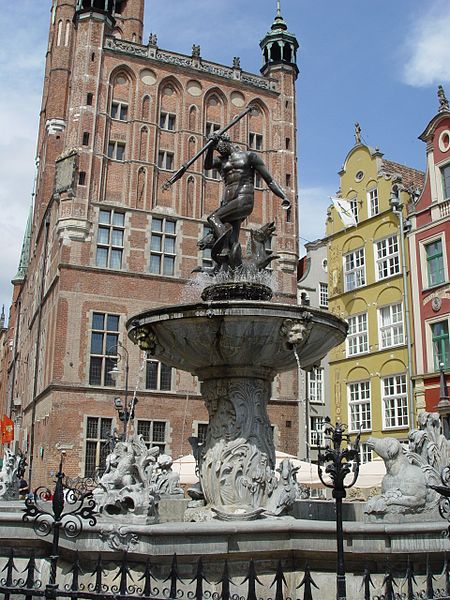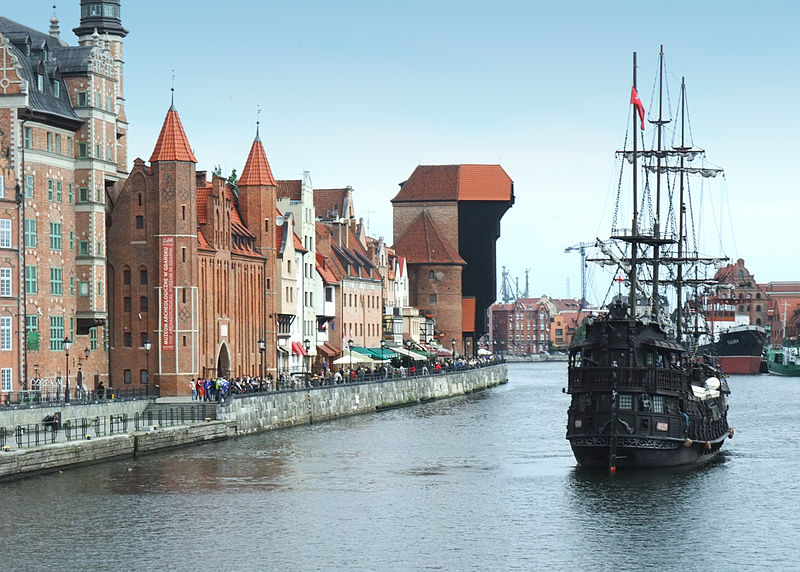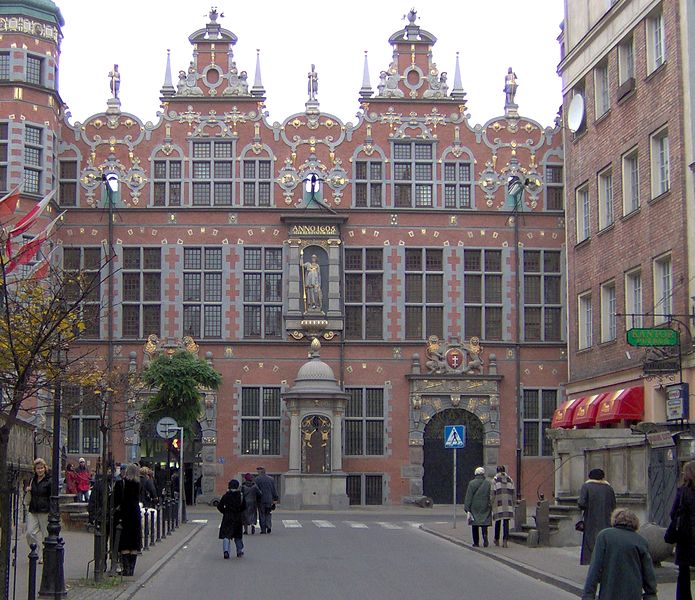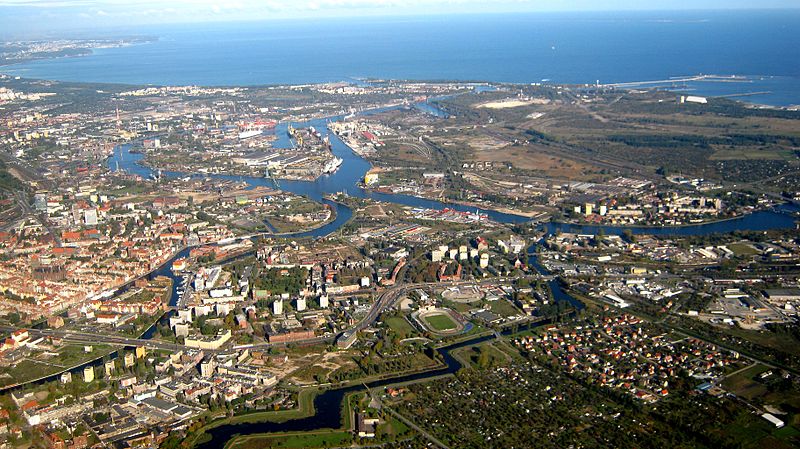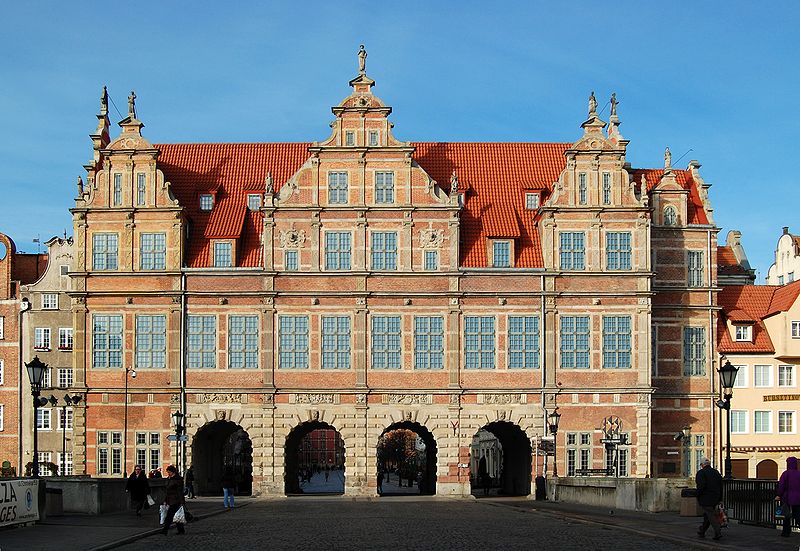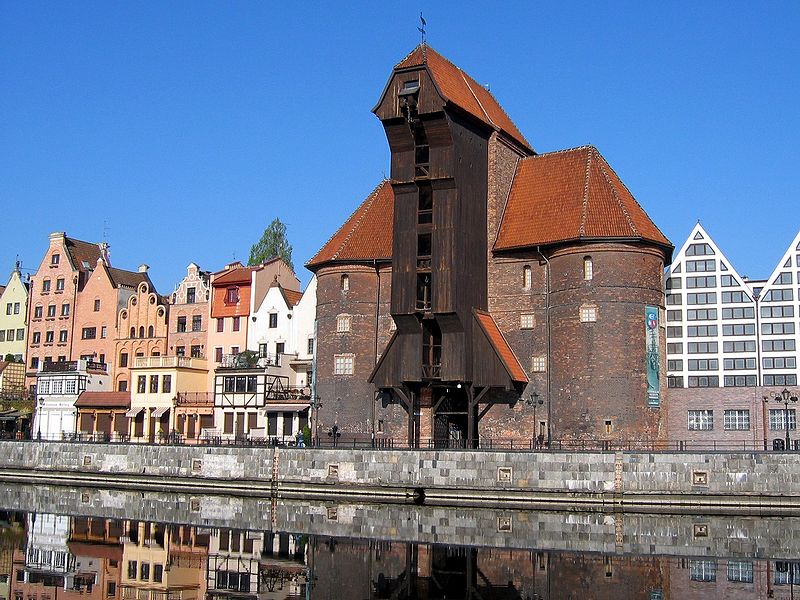<Back to Index>
- Pomerania, Poland Gdańsk, 456K
PAGE SPONSOR

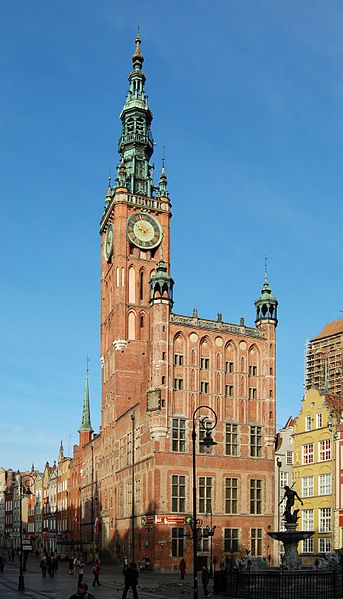
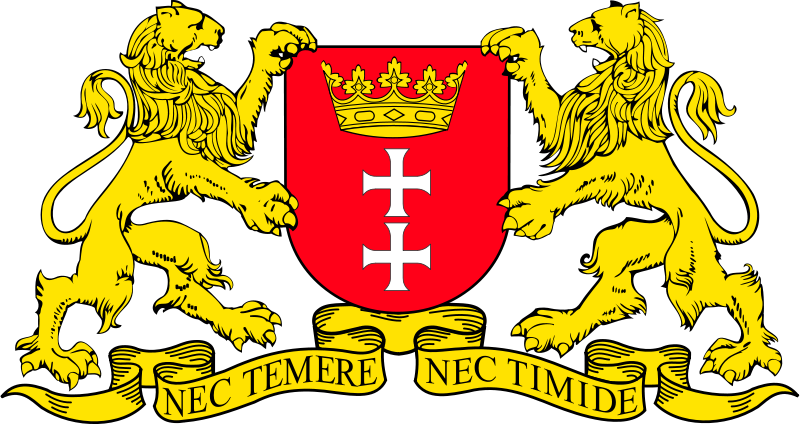
Gdańsk (German: Danzig) is a Polish city on the Baltic coast, at the center of the country's fourth largest metropolitan area.
The city lies on the southern edge of Gdańsk Bay (of the Baltic Sea), in a conurbation with the city of Gdynia, spa town of Sopot, and suburban communities, which together form a metropolitan area called the Tricity (Trójmiasto), with a population of over 800,000. Gdańsk itself has a population of 455,830 (June 2010), making it the largest city in the Pomerania region of Northern Poland.
Gdańsk is Poland's principal seaport as well as the capital of the Pomeranian Voivodeship. It is also historically the largest city of the Kashubian region. The city is close to the former late medieval / modern boundary between West Slavic and Germanic lands and it has a complex political history with periods of Polish rule, periods of German rule, and extensive self rule, with two spells as a free city. It has been part of modern Poland since 1945.
Gdańsk is situated at the mouth of the Motława River, connected to the Leniwka, a branch in the delta of the nearby Vistula River, whose waterway system supplies 60% of the area of Poland and connects Gdańsk to the national capital in Warsaw. This gives the city a unique advantage as the center of Poland's sea trade. Together with the nearby port of Gdynia, Gdańsk is also an important industrial center. Historically an important seaport and shipbuilding center, Gdańsk was a member of the Hanseatic League.
The city was the birthplace of the Solidarity movement which, under the leadership of political activist Lech Wałęsa, played a major role in bringing an end to Communist rule across Central Europe.
The city's name is thought to originate from the Gdania River, the original name of the Motława branch on which the city is situated. Gdańsk and Gdania are considered to be derivations from the Gothic name of the area (Gutiskandja), however this has also been questioned. Like many other Central European cities, Gdańsk has had many different names throughout its history.
The name of a settlement was recorded after St. Adalbert's death in 997 AD as urbs Gyddanyzc and later was written as Kdanzk (1148), Gdanzc (1188), Danceke (1228), Gdansk (1236, 1454, 1468, 1484, 1590), Danzc (1263), Danczk (1311, 1399, 1410, 1414 – 1438), Danczik (1399, 1410, 1414), Danczig (1414), Gdąnsk (1636).
Since the 16th century, the majority of the city's inhabitants were German speakers. Other former spellings of the name include Dantzig, Dantsic and Dantzic.
In the Kashubian language the city is called Gduńsk. The city's Latin name may be given as either Gedania, Gedanum or Dantiscum; the variety of Latin names reflects the mixed influence of the city's Polish, German and Kashubian heritage.
Ceremonial names on special occasions the city is also referred to as "The Royal Polish City of Gdańsk" (Polish Królewskie Polskie Miasto Gdańsk, Latin Regia Civitas Polonica Gedanensis, Kashubian Królewsczi Polsczi Gard Gduńsk).
Kashubians also use the name "Our Capital City Gdańsk" (Nasz Stoleczny Gard Gduńsk) or "The Kashubian Capital City Gdańsk" (Stoleczny Kaszëbsczi Gard Gduńsk).
Early settlements in the area are associated with the Wielbark culture; and after the Great Migrations, they were replaced by a Pomeranian settlement that probably dates back to the 7th century. In the 980s, a stronghold was built most probably by Mieszko I of Poland who thereby connected the Polish state ruled by the Piast dynasty with the trade routes of the Baltic Sea. The first written record of this stronghold is the vita of Saint Adalbert, written in 999 and describing events of 997. This date is generally regarded as the founding of Gdańsk in Poland; in 1997 the city celebrated the millennial anniversary of the year 997 when Saint Adalbert of Prague baptized the inhabitants of the settlement on behalf of Boleslaw the Brave of Poland. In the 12th century, the settlement became part of the Samborides' duchy and consisted of a settlement at the modern Long Market, craftmens' settlements along the Altstädter Graben ditch, German merchant settlements around the St Nicolas church and the old Piast stronghold. In 1186, a Cistercian monastery was set up in nearby Oliwa, which is now within the city limits. In 1215, the ducal stronghold became the center of a Pomerelian splinter duchy. In 1224 / 25, Germans in the course of the Ostsiedlung established a settlement in the area of the earlier fortress.
About 1235, the town was granted city rights under Lübeck law by Pomerelian duke Swantopolk II, an autonomy charter similar to that of Lübeck which was also the primary origin of many settlers. In 1300, the town had an estimated population of 2,000. While overall the town was not that an important trade center at that time, it had some relevance in the trade with Eastern Europe. In 1308, the town was besieged by Brandenburg and the Teutonic Knights were hired by the Polish king Władysław I the Elbow - high to restore order. Subsequently, they took over control of the town and killed many of its inhabitants. Primary sources record a massacre of 10,000 people, but the exact number killed is subject of dispute in modern literature: Some authors accept the number given in the original sources, while others consider 10,000 to have been a medieval exaggeration. The massacre was used as evidence by the Polish crown in a subsequent papal lawsuit.
The knights colonized the area, replacing local Kashubians with German settlers. In 1308, they founded Osiek Hakelwerk near the town, initially as a Slavic fishing settlement. In 1340, the Teutonic Knights built a large fortress, which became the seat of the knights' Komtur. In 1343, they founded Rechtstadt, which in contrast to the pre-existing town (thence Altstadt, "Old Town" or Stare Miasto) was chartered with Kulm Law. In 1358, Danzig joined the Hanseatic League, and became an active member in 1361. It maintained relations with the trade centers Bruges, Novgorod, Lisboa and Sevilla. In 1377, the Old Town's city limits were expanded. In 1380,Neustadt ("New Town" or "Nowe Miasto") was founded as the fourth, independent settlement.
After a series of Polish - Teutonic Wars, in the Treaty of Kalisz (1343) the Order had to acknowledge that it would hold Pomerelia as an alm from the Polish Crown. Although it left the legal basis of the Order's possession of the province in some doubt, the city thrived as a result of increased exports of grain (especially wheat), timber, potas, tar, and other goods of forestry from Prussia and Poland via the Vistula River trading routes, despite the fact that after its capture, the Teutonic Knights tried to actively reduce the economic significance of the town. While under the control of the Teutonic Order German migration increased. A new war broke out in 1409, ending with the Battle of Grunwald (1410), and the city came under the control of the Kingdom of Poland. A year later, with the first First Peace of Thorn, it returned to the Teutonic Order. In 1440, the city participated in the foundation of the Prussian Confederation which was an organization opposed to the rule of the Teutonic Knights. This led to the Thirteen Years' War of independence from the Teutonic Monastic State of Prussia (1454 – 1466). On May 25, 1457, when the city – jointly with Royal Prussia – became part of the Crown of Poland while maintaining its rights and independence as an autonomous city.
On 15 May 1457, Casimir IV of Poland granted Gdańsk the Great Privilege, after he had been invited by the town's council and had already stayed in town for five weeks. With the Great Privilege, the town was granted autonomy within the Kingdom of Poland. The
privilege confirmed to the town independent jurisdiction, legislation
and administration of her territory, and the rights of the Polish crown
were limited to the following: The Polish king was allowed to stay in
town for three days a year, he was further allowed to choose a permanent
envoy from eight councilmen proposed to him by the town, and received
an annual payment. Furthermore, the privilege united Old Town, Hakelwerk and Rechtstadt, and legalized the demolition of New Town, which had sided with the Teutonic Knights. Already in 1457, New Town was demolished completely, no buildings remained.
Gaining free and privileged access for the first time to Polish markets, the seaport prospered while simultaneously trading with the other Hanseatic cities. After the Second Peace of Thorn (1466) with the Teutonic Monastic State of Prussia the warfare between the latter and the Polish crown ended permanently. After the incorporation of Royal Prussia by the Kingdom of Poland in 1569, the city continued to enjoy a large degree of internal autonomy (Danzig Law).
King Stephen Báthory's attempt to subject the city, which had supported Maximilian II in
the prior election of the king, failed. The city, encouraged by its
immense wealth and almost impregnable fortifications, as well as by the
secret support of Denmark and Emperor Maximilian, shut its gates against Stephen. After the Siege of Danzig (1577),
lasting six months, the city's army of 5,000 mercenaries was utterly
defeated in a field battle on December 16, 1577. However, since
Stephen's armies were unable to take the city by force, a compromise was
reached: Stephen Báthory confirmed the city's special status and her Danzig Law privileges granted by earlier Polish kings. The city recognized him as ruler of Poland and paid the enormous sum of 200,000 guldens in gold as payoff ("apology").
Beside the German speaking majority, whose elites sometimes distinguished their German dialect as Pomerelian, the city was home to a large number of Polish speaking Poles, Jewish Poles, and Dutch. In addition, a number of Scotsmen took refuge or immigrated to and received citizenship in the city. During the Protestant Reformation, most German speaking inhabitants adopted Lutheranism. Due to the special status of the city and significance within the Polish – Lithuanian Commonwealth, the city inhabitants largely became bi-cultural sharing both Polish and German culture and attached to the traditions of the Commonwealth state.
The city suffered a slow economic decline due to the wars of the 18th century, when it was taken by the Russians after the Siege of Danzig in 1734. Danzig was annexed by the Kingdom of Prussia in 1793. During the era of Napoleon Bonaparte the city became a free city in the period extending from 1807 to 1814. After France's defeat in the Napoleonic Wars it again became part of Prussia and became the capital of Regierungsbezirk Danzig within the province of West Prussia from 1815. The city's longest serving Regierungspräsident was Robert von Blumenthal, who held office from 1841, through the revolutions of 1848, until 1863. The city became part of the German Empire in 1871.
Throughout its long history, Gdańsk has faced various periods of rule by different states: 997–1308: as part of the Kingdom of Poland; 1308 – 1454: as part of the territory of the Teutonic Order; 1454 – 1466: Thirteen Years' War; 1466 – 1569: as part of the Kingdom of Poland; 1569 – 1793: as part of Polish – Lithuanian Commonwealth; 1793 – 1805: as part of Prussia; 1807 – 1814: as a free city; 1815 – 1871: as part of Prussia; 1871 – 1920: as part of Imperial Germany; 1920 – 1939: as a free city; 1939 – 1945: as part of Nazi Germany; 1945 – 1989: as part of Polish People's Republic; 1989 – present: as part of Republic of Poland.
When Poland regained its independence after World War I with access to the sea as promised by the Allies on the basis of Woodrow Wilson's "Fourteen Points" (point 13 called for "an independent Polish state", "which should be assured a free and secure access to the sea"), the Poles hoped the city's harbor would also become part of Poland. However, since Germans formed a majority in the city, with Poles being a minority (in the 1923 census 7,896 people out of 335,921 gave Polish, Kashubian or Masurian as their native language, but Polish estimates of the Polish minority during the interwar era range from 37,000 to 100,000 (9% – 34%)), the city was not placed under Polish sovereignty. Instead, in accordance with the terms of the Versailles Treaty, it became the Free City of Danzig, an independent quasi - state under the auspices of the League of Nations with its external affairs largely under Polish control. Poland's rights also included free usage of the harbor, a Polish post office, a garrison in Westerplatte district, customs union with Poland etc. This led to a considerable tension between the city and the surrounding Republic of Poland. The Free City had its own constitution, national anthem, parliament (Volkstag), and government (Senat). It issued its own stamps as well as currency.The German population of the Free City of Danzig favored reincorporation into Germany. In the early 1930s the local Nazi Party capitalized on these pro-German sentiments and in 1933 garnered 50% of vote in the parliament. Thereafter, the Nazis under Gauleiter Albert Forster achieved dominance in the city government, which was still nominally overseen by the League of Nations' High Commissioner. The German government officially demanded the return of Danzig to Germany along with an extraterritorial (meaning under German jurisdiction) highway through the area of the Polish Corridor for land based access between those parts of Germany. Hitler used the issue of the status city as pretext for attacking Poland and on May 1939, during a high level meeting of German military officials explained to them: It is not Danzig that is at stake. For us it is a matter of expanding our Lebensraum in the east, adding that there will be no repeat of the Czech situation, and Germany will attack Poland at first opportunity, after isolating the country from its Western Allies. As Nazi demands increased, German - Polish relations rapidly deteriorated. Germany invaded Poland on September 1 after having signed a non - aggression pact with the Soviet Union in late August. The German attack began in Danzig, with a bombardment of Polish positions at Westerplatte by the German battleship Schleswig - Holstein, and the landing of German infantry on the peninsula. Outnumbered Polish defenders at Westerplatte resisted for seven days before running out of ammunition. Meanwhile, after a fierce day long fight (1 September 1939), defenders of the Polish Post office were murdered and buried on the spot in the Danzig quarter of Zaspa in October 1939. To celebrate the surrender of Westerplatte, the NSDAP organized a night parade on September 7 along the Adolf - Hitlerstrasse that was inadvertently attacked by a Polish hydroplane taking off from Hel Peninsula. The city was officially annexed by Nazi Germany and incorporated into the Reichsgau Danzig - West Prussia.
About 50 percent of members of the Jewish Community of Danzig had left the city within a year after a Pogrom in October 1937, after the Kristallnacht riots in November 1938 the community decided to organize its emigration and in March 1939 a first transport to Palestine started. By September 1939 barely 1,700 mostly elderly Jews remained. In early 1941 just 600 Jews were still living in Danzig who were later murdered in the Holocaust. Out of the 2,938 Jewish community in the city 1,227 were able to escape from the Nazis before the outbreak of war. Nazi secret police had been observing Polish minority communities in the city since 1936, compiling information, which in 1939 served to prepare lists of Poles to be captured in Operation Tannenberg. On the first day of the war, approximately 1,500 ethnic Poles were arrested, some because of their participation in social and economic life, others because they were activists and members of various Polish organizations. On September 2, 1939, 150 of them were deported to the Stutthof concentration camp some 30 miles from Danzig, and murdered. Many Poles living in Danzig were deported to Stutthof or executed in the Piaśnica forest.
In 1941, the German government ordered the invasion of the Soviet Union, eventually causing the fortunes of war to turn against it. As the Soviet Army advanced in 1944, German populations in Central and Eastern Europe took flight, resulting in the beginning of a great population shift. After the final Soviet offensive began in January, 1945, hundreds of thousands of German refugees, many of whom had fled to Danzig on foot from East Prussia (evacuation of East Prussia), tried to escape through the city's port in a large scale evacuation involving hundreds of German cargo and passenger ships. Some of the ships were sunk by the Soviets, including the Wilhelm Gustloff after an evacuation was attempted at neighboring Gdynia. In the process, tens of thousands of refugees were killed.
The
city also endured heavy Allied and Soviet air raids. Those who survived
and could not escape had to face the Soviet Army, which captured the
city on March 30, 1945. The city was heavily damaged. In line with the decisions made by the Allies at the Yalta and Potsdam conferences, the city became part of Poland. The remaining German residents of the city who had survived the war fled or were forcibly expelled to postwar Germany, and the city was repopulated by ethnic Poles, up to 18 percent (1948) of them had been deported by the Soviets in two major waves from Polish areas annexed by the Soviet Union, i.e. from the eastern portion of pre-war Poland.
Parts of the historic old city of Gdańsk, which had suffered large scale destruction at the hands of the Soviet Army, were rebuilt during the 1950s and 1960s. The reconstruction is not tied to the city’s pre-war appearance, instead its politically motivated purpose was to rebuild an idealized pre 1793 state. Any traces of German tradition were ignored or regarded as "Prussian barbarism" worthy of demolition while Flemish - Dutch, Italian and French influences were emphasized.
Boosted by heavy investment in the development of its port and three major shipyards for Soviet ambitions in the Baltic region, Gdańsk became the major shipping and industrial center of the Communist People's Republic of Poland.
In December 1970, Gdańsk was the scene of anti - regime demonstrations, which led to the downfall of Poland's communist leader Władysław Gomułka. During the demonstrations in Gdańsk and Gdynia, the military as well as the police opened fire on the demonstrators causing several dozen deaths. Ten years later, on August 31, 1980, Gdańsk Shipyard was the birthplace of the Solidarity trade union movement, whose opposition to the Communist regime led to the end of Communist Party rule in 1989, and sparked a series of protests that successfully overturned the Communist regimes of the former Soviet bloc. Solidarity's leader, Lech Wałęsa became President of Poland in 1990. Gdańsk native Donald Tusk became Prime Minister of Poland in 2007.
Today Gdańsk is a major shipping port and tourist destination.
Gdańsk enjoys a temperate climate, with cold, cloudy, moderate winters and mild summers with frequent showers and thunderstorms. Average temperatures range from -1.0 to 17.2 °C (30 to 63 °F) and rainfall varies from 31.0 mm/month to 84.0 mm/month. In general it is a maritime climate and therefore damp, variable and mild.
The seasons are clearly differentiated. Spring starts in March and is initially cold and windy, later becoming pleasantly warm and often very sunny. Summer, which begins in June, is predominantly warm but hot at times (with temperature reaching as high as 30 - 35C at least once per year) with plenty of sunshine interspersed with heavy rain. The average annual hours of sunshine for Gdańsk are 1600, similar to other Northern cities. July and August are the hottest months. Autumn comes in September and is at first warm and usually sunny, turning cold, damp and foggy in November. Winter lasts from December to March and includes periods of snow. January and February are the coldest months with the temperature sometimes dropping as low as −15 °C (5 °F).
The
industrial sections of the city are dominated by shipbuilding,
petrochemical and chemical industries, and food processing. The share of
high tech sectors such as electronics, telecommunications, IT
engineering, cosmetics and pharmaceuticals is on the rise. Amber processing is also an important part of the local economy, as the majority of the world's amber deposits lie along the Baltic coast. The Pomeranian Voivodeship, including Gdańsk, is also a major tourist destination in the summer months, as millions of Poles and European Union citizens flock to the beaches of the Baltic coastline.
The city has many fine buildings from the time of the Hanseatic League. Most tourist attractions are located along or near Ulica Długa (Long Street) and Długi Targ (Long Market), a pedestrian thoroughfare surrounded by buildings reconstructed in historical (primarily 17th century) style and flanked at both ends by elaborate city gates. This part of the city is sometimes referred to as the Royal Road as the former path of processions for visiting kings.
Walking from end to end, sites encountered on or near the Royal Way include: Upland Gate (Brama Wyżynna), Torture House (Katownia), Prison Tower (Wieża więzienna), Golden Gate (Złota Brama), Long Street (Ulica Długa), Uphagen House (Dom Uphagena), Main Town Hall (Ratusz Głównego Miasta), Long Market (Długi Targ), Artus' Court (Dwór Artusa), Neptune Fountain (Fontanna Neptuna), Golden House (Złota kamienica), Green Gate (Zielona Brama).
Gdańsk has a number of historical churches: St. Bridget, St. Catherine, St. John, St Mary (Bazylika Mariacka), a municipal church built during the 15th century, is the largest brick church in the world, St Nicholas' Church, Church of the Holy Trinity.
The National Museum contains a number of important artworks, including Hans Memling's Last Judgement
The museum ship SS Soldek is anchored on the Motława River and was the first ship built in post war Poland.
In the 16th century, Gdańsk hosted Shakespearean theater on foreign tours, and the Danzig Research Society founded in 1743 was one of the first of its kind. Currently, there is a Fundation Theatrum Gedanensis aimed at rebuilding the Shakespeare theater at its historical site. It is expected that Gdańsk will have a permanent English language theater, as at present it is only an annual event.
- Gdańsk Lech Wałęsa Airport – an international airport located in Gdańsk;
- Port of Gdańsk – a seaport located on the southern coast of Gdańsk Bay within the city;
- Gdańsk Główny (PKP station) – major railway passenger station with PKP Intercity and SKM service;
- Szybka Kolej Miejska – an urban transportation service of Tricity;
- City buses and trams are operated by ZTM Gdańsk (Zarząd Transportu Miejskiego w Gdańsku).
- Obwodnica Trojmiejska – part of expressway S6 that bypasses the cities of Gdańsk, Sopotand Gdynia.
Train transportation provides connections with all major Polish cities, and with the neighboring Kashubian Lakes region. The A1 motorway connects the port and city of Gdańsk with the southern border of the country.
Gdańsk is the starting point of the EuroVelo 9 cycling route which continues southward through Poland, then into the Czech Republic, Austria and Slovenia before ending at the Adriatic Sea in Pula, Croatia.
There are many popular professional sports teams in the Gdańsk and Tricity area. Amateur sports are played by thousands of Gdańsk citizens and also in schools of all levels (elementary, secondary, university). A Construction is in process for the Euro 2012 stadium that will hold a capacity of 44,000 seats.
The city's professional football club is Lechia Gdansk. Founded in 1945, they play in the Ekstraklasa, Poland's top division. Their home stadium, PGE Arena, is one of the four Polish stadiums to host the UEFA Euro 2012 competition.
Contemporary Gdańsk is the capital of the province called Pomeranian Voivodeship and is one of the major centers of economic and administrative life in Poland. Many important agencies of the state and local government levels have their main offices here: the Provincial Administration Office, the Provincial Government, the Ministerial Agency of the State Treasury, the Agency for Consumer and Competition Protection, the National Insurance regional office, the Court of Appeals, and the High Administrative Court.
Gdańsk Voivodeship was extended in 1999 to include most of former Słupsk Voivodeship, the western part of Elbląg Voivodeship and Chojnice County from Bydgoszcz Voivodeship to form the new Pomeranian Voivodeship.
The area of the region was thus extended from 7,394 km² to
18,293 km² and the population rose from 1,333,800 (1980) to
2,198,000 (2000). By 1998, Tricity constituted an absolute majority of the population; almost half of the inhabitants of the new region live in the center.
There are 14 higher schools including 3 universities with a total of 60,436 students, including 10,439 graduates as of 2001: Gdańsk University (Uniwersytet Gdański), Gdańsk University of Technology (Politechnika Gdańska), Gdańsk Medical University (Gdański Uniwersytet Medyczny), Academy of Physical Education and Sport of Gdańsk (Akademia Wychowania Fizycznego i Sportu im. Jędrzeja Śniadeckiego), Musical Academy (Akademia Muzyczna im. Stanisława Moniuszki), Arts Academy (Akademia Sztuk Pięknych), Instytut Budownictwa Wodnego PAN, Ateneum – Szkoła Wyższa, Gdańska Wyższa Szkoła Humanistyczna, Gdańska Wyższa Szkoła Administracji, Wyższa Szkoła Bankowa, Wyższa Szkoła Społeczno - Ekonomiczna, Wyższa Szkoła Turystyki i Hotelarstwa w Gdańsku, Wyższa Szkoła Zarządzania.
